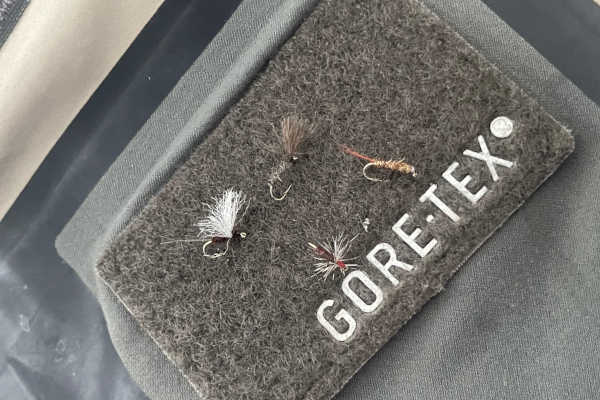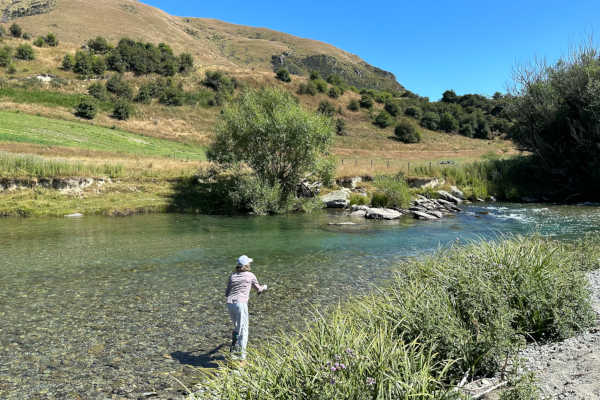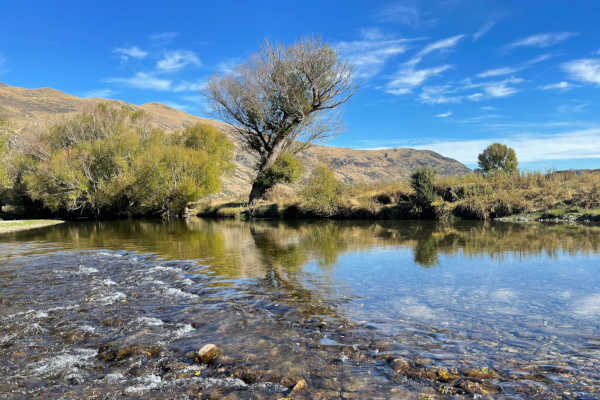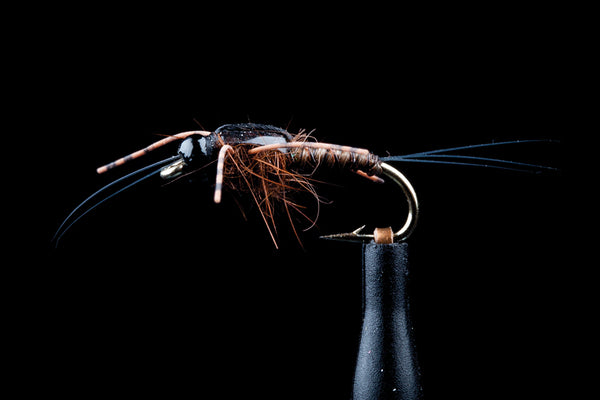The Spent Spinner | The Mataura River Series by Chris Dore
Welcome to part 5 of a river that is forever flowing in both content and water too. If you want to learn a thing about one of New Zealand's best trout fishing rivers, then you ask one of New Zealand's best fishermen - Chris Dore.
The Mataura River Series by Chris Dore
Part 5 | The Spent Spinner
In Norman Marsh’s book ‘Trout Stream Insects of New Zealand’ (Millwood press, 1983), he aptly describes the appearance of the spinner in one word…’Brilliant’.
Spinners are notably slimmer and more elegant than duns. In their final stages, Deletidium spinners are a mahogany – red in color with amber, or ginger colored legs and cerci.
They have clear, glassy wings, which reflect light when upon the water, giving off a ‘shiny’ appearance.
Again, the differences between the spinners of the two featured species are minimal, and both can be effectively imitated with the one pattern.
At times of little wind, male spinners will form ‘mating swarms’ near the water to attract females. After mating the males will expire, while the female returns to the streamside grasses for her eggs to mature.
Female spinners require moderately warm, calm conditions in which to lay their eggs. Any wind stronger than a light breeze will bring difficulty to this process, and often precludes spinners from reaching the water. Thus, both dawn and dusk are favored times to experience a fall of returning, egg laden spinners.
Some of the most prolific spinner falls will occur within the final hour of daylight, a time when the wind will often drop along with the setting sun, and when most birds which prey upon mayflies have taken to their roost.
However, a spinner fall can occur at any time of the day providing the wind is kind, more so in overcast weather.
In his book, ‘Norman Marsh’s Fly box’ (Halcyon press 1995), Marsh suggests that while aquatic insects enjoy warm conditions, they dislike direct heat. This explains why spinner falls will occur throughout the day in cloudy conditions, and of course, at times when the sun is at its least intense.
Early morning spinner falls too are a regular occurrence upon the Mataura across the warmer months, coinciding with the rising sun warming the grasses in which the spinners rest.
Female spinners will invariably fly in an upstream direction before laying their eggs. This behavior, in conjunction with the downstream drift of her eggs ensures a stable colonization of mayfly within that section of water.
Without these upstream flight patterns, mayfly populations would eventually drift into the sea.

Spinners will land on the riffles, the sections of increased surface velocity to drop their eggs. The ripply surface minimizes the meniscus, enabling the egg ‘cluster’ to pass through the surface film with minimal difficulty.
The meniscus will be thicker upon the pools, and some smaller clusters may not successfully break through this.
After depositing her eggs the spinner will then expire herself, falling ‘spent’ upon the water to provide the trout with a final feast as they drift peacefully down through the pools.
Deleatidium vernale are often referred to locally as the ‘Mataura midge’, and will return to the river in many thousands, often inciting great sport at last light. Great swarms may be seen hovering above river, and then just falling like stones, as they meet their watery demise.
Trout will ‘lock on’ and feed selectively upon these spent spinners as they drift upon the surface in their thousands.
Spent mayflies drift at the mercy of the currents, and are often concentrated in great numbers amongst the backwaters, eddies and along the slower river margins, providing dry fly opportunities long after the initial rise has ended. These are also productive locations to prospect during the lighter spinner falls, as larger numbers of mayflies here will keep trout more interested than those few drifting down the main river.
Spent mayfly will not float forever and will eventually sink, more so in the more turbulent water of the ripples.
Trout will feed upon these sunken spinners well after the rise has ended, and the angler who targets the bases of ripples with a suitable imitation will increase his success as the rise tapers off.
To the chase...
So how do we imitate these creatures of which the trout scrutinize closely in glassy calm pools, and glides? The answer is carefully, and with an observant eye.

Size, I believe is the most important aspect of a spinner imitation, moreso than any other phase of the mayfly lifecycle. The difference between a 16 and an 18 pattern may not seem important to us, as anglers, but to the trout, these extra few millimeters can mean the difference between a sip, and a refusal. In their book, 'Selective Trout', Swisher and Richards suggest that as the size of the natural gets smaller, the trout will become more selective, and it becomes imperative that your imitation matches the hatch in both size and profile. Many trout, in my opinion, are put down by flies which are far too heavily dressed.
If in doubt as to which size to use, choose the smaller.
Worth mentioning is that I do not use an imitation of the upright spinner (those still alive, and returning to lay their egg sack), and find that fish will readily accept a suitable emerger, or a spent pattern when targeting these. My upwing spinner, being a no hackle pattern sits low enough in the film to throw out the suggestion of spent wings. This all changes, however when the spinner expires and drifts helplessly upon the surface. Trout will now become extremely selective during this phenomenon recognized internationally as the 'mad Mataura rise'.
If trout are opportunistic feeders, then what causes them to lock onto one food form and feed so selectively? John Hayes in his and Les Hills excellent book, The Artful Science of Trout Fishing suggests that trout are more likely to feed selectively when food is abundant. When one food source is readily available in abundance, trout will key into this to take advantage of the opportunity to maximize food intake whilst minimizing their energy expenditure.
Dr Hayes then goes on to explain that trout must discern between various forms of flotsam and other floating debris and authentic prey items.
As mentioned earlier, trout will create a prey image, utilising any number of triggers allowing them to recognize a given food source.
Suggested triggers for spent spinners may include the bodies imprint flush within the waters surface, the light pattern from the body sitting low within the surface, and the legs possibly protruding beneath the meniscus, or maybe the sparkling light pattern thrown out by the shiny, transparent wings, laying prone, stuck to the surface. I personally feel a strong tail and abdomen silhouette, and the hint of the wing is the key to a good spent spinner pattern.

So how best do we imitate this lifeless, yet irresistible creature?
I utilize two styles of fly when fishing a spinner fall; the traditional Mahogany Spent Spinner tie, and a sparsely tied upwing pattern, for use on more joggly water, and in low light conditions, when visually locating ones fly becomes tricky..
The Mataura spinner is a simple tie and is as follows;
Hook; TMC 100 sizes 16 - 18
Tail; 2 - 3 tailing fibers well separated via a small ball of dubbing
Abdomen / Thorax; Mahogany colored poly dub, tied sparse, and tapering towards the head
Wing; CDC, Aero Wing, or Z - lon, tied spent and sparse to imitate the natural.
My upwing is of a similar tie, except I substitute the spent wing for an upright split wing of Tiemco Aero yarn in a dark dun grey. This is a no hackle, David Murray Orr pattern.
When fishing a spinner fall I like to use the longest, lightest leader possible for the conditions. This often means 12 feet of tapered leader attached to 3 or 4 feet of 5x or 6x copolymer. This is a time when ones tippet must not float upon the surface, and so an application of Loon Snake River Mud dulls the shine and helps your nylon break through the film.
Often, when fishing to trout rising along the edges of calm, smooth pools it is not wise to cast from behind the trout, especially as they are normally holding just beneath the surface. The landing of ones tippet within the window of vision, however reduced this may be, will often put these fish down.
Alternatively, as when fishing emergers, I like to position myself adjacent to the trout, and cast my fly across to them. As mentioned, when the hatch is heavy the trout will hold closer to the surface, thus his window of vision is severely reduced. You may move in closer to the trout’s position than if he was holding deep, under reasonable concealment. Your fly will land to one side of the trout, with the tippet and adjoining leader falling well away from the fish. When performed correctly your fly will be the first and hopefully only thing your prey will see.

On larger, calmer pools and tail outs I generally enter at the top of the pool and fish my way downstream to rises employing longer tippets and higher trajectory forward casts to generate slack, and upstream reach mends to facilitate longer downstream, drag free drifts and absolute fly first presentations.
Spinners often drift in large clusters, and it is often difficult to decide if the rise was to your fly, or to a natural. This is when the use of two dries comes into play.
At these times I will utilize a small, high viz parachute pattern tied onto the tippet, then on a dropper off the bend of this, say 15 inches or so behind I will attach my standard spent spinner pattern. This not only gives you two chances at deceiving the wily trout, but the parachute with its hi viz post help you in identifying both the position of your tail fly, and in detecting any takes you may not have decided upon.
As the spinner fall tapers off and trout return to the depths, do not believe the dry fly opportunities are over.
Spinners will drift at the mercy of the currents, and ultimately congregate in backwaters, eddies, and along the windward river margins, and trout will cruise these places well after the main act has ended, rising leisurely to the 'leftover' spoils.
Those spent spinners which stay in the main current will eventually be dragged beneath the surface, and even throughout the spinner fall, those prospecting the bases of ripples with a suitable nymph or wet fly can pull up some good fish. Traditional wet flies such as the dark red spinner work well across and down, and can bring fish to the net in places where the angler has trouble in deceiving them by way of the dry. There are few specialist tricks required here, just fish two suitable patterns in tandem, and swing them through the ripple on a short, tight line, paying special attention to the meeting of the ripple, and the slower rivers edge.
The Mataura river dry fly sessions are legendary throughout international angling circles and provide perhaps New Zealand finest 'technical fly fishing' opportunities to a large population of fighting fit brown trout. Not all Mataura fish are large, 18 inches (a shade below 3lbs) being the average size, but during a good rise the angler will find himself with countless opportunities for deceiving free rising southern trout. How you handle the excitement is up to you.
Check out more in our Mataura River series:
- Part One - Fly Fishing the Mataura River | An introduction
- Part Two - Nymph Fishing The Mataura River
- Part Three - Rising Trout On The Mataura
- Part Four - The Emerging Dun
ABOUT THE AUTHOR:
Chris Dore is a battle-tested fly fishing guide with over 15 years of professional guiding experience, battling the demanding, ever-changing conditions that our New Zealand rivers throw at us.
In 2006 Chris became one of the first New Zealanders to successfully pass the internationally recognised Federation of Fly Fishers Certified Casting Instructors examination and has since taught many thousands of anglers to up their skillset.
For more in person and on river fly fishing advice and upskilling why not book Chris for a day or three?



